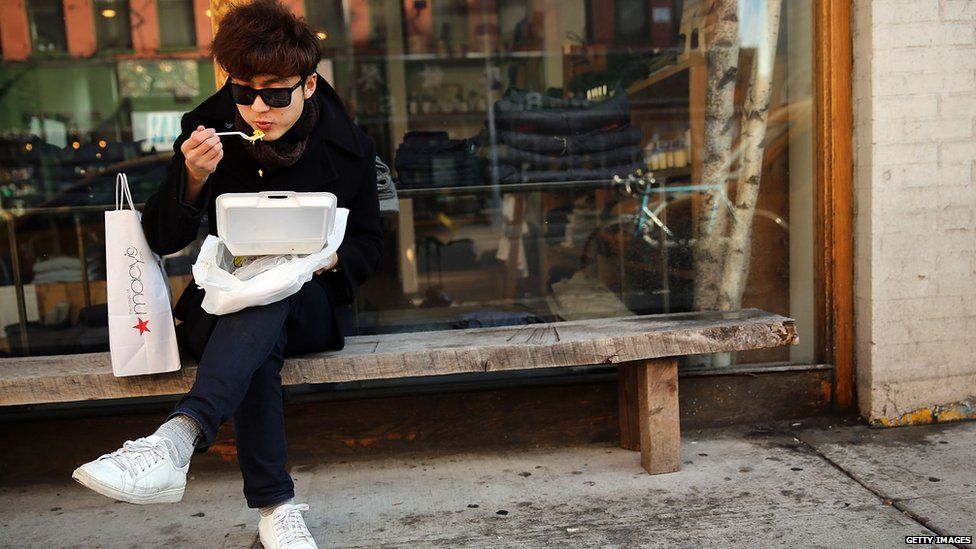Why New York banned polystyrene foam
- Published

New York City is joining a growing group of cities in banning Expandable Polystyrene Foam (EPS). Adam Harris explains what makes this material so worrisome to environmentalists - and appealing to businesses.
Starting today, single-use EPS products including cups, bowls, plates, takeout containers and trays and packing peanuts are not allowed to be possessed, sold, or offered in New York City. Companies have six months to comply or face a fine.
"These products cause real environmental harm and have no place in New York City. We have better options," said New York Mayor Bill de Blasio in a release about the ban.
So why has EPS come under fire? And what is it, exactly? Here's a quick guide to this long-lasting material.
What is EPS anyway?
Marketed in the US under the name Styrofoam, EPS was invented by Dow Chemical scientist Otis Ray McIntire in 1941.
To make it, small beads of the polymer polystyrene are steamed with chemicals until they expanded to 50 times their original volume. After cooling and settling, the pre-expanded beads are then blown into a mould - such as that of a drink cup or cooler - and steamed again, expanding further, until the mould is completely filled and all of the beads have fused together.
The finished product is a lightweight, inexpensive material that is about 95% air. The insulating properties and cheap manufacturing costs of EPS have made it a popular choice for businesses.
What makes it so bad for the environment?
It is estimated that Americans alone throw away 25 billion polystyrene coffee cups a year - a lot, but not compared to the 100 billion plastic bags used annually by Americans.
And in 2006, for instance, 135 tons of polystyrene waste was dumped into Hong Kong landfills. Still, that only accounted for a small fraction of Hong Kong's plastic waste - less than 5%.
But environmentalists say that EPS waste causes outsized trouble when it leaks into marine environments and contaminates water.
According to Douglas McCauley, a marine biology professor at the University of California, Santa Barbara, there are two main issues that polystyrene causes for marine animals - mechanical and chemical.
"The [mechanical root] is very straight-forward," said McCauley, "Oftentimes, we find polystyrene foam lodged in the intestines that causes blockages that can be lethal. If you think about how we worry about a mild blockage from eating the wrong thing, imagine eating a ball of Styrofoam. That's what some of these animals are doing."
Chemically, absorbent properties make EPS even more dangerous. "Polystyrene foams essentially act like little pollutant sponges, picking up and concentrating some of the nastiest contaminants in the ocean," McCauley says. "Then something like a sea turtle comes along and eats this thinking it is a jellyfish."
That's not just bad for the fish and the oceans. It could be bad for humans.
"It is very worrisome to me that some of these plastic-feeding fish may be ending up back on our tables," says McCauley.
Why can't you recycle it?
The difficulty recycling EPS was a main reason New York City enacted the ban.
Kathryn Garcia, New York City's sanitation commissioner, said: "It has not been proven that recycling dirty foam can be done on a large scale, and there is no demonstrated market for this material."
Due to the chemical process that turns polystyrene beads into EPS, it's nearly impossible to turn an EPS plate, for example, into an EPS takeaway box.
"You couldn't just take recycled Styrofoam cups and make moulds again because it's already expanded," says Joe Biernacki, professor of chemical engineering at Tennessee Tech University. "What you need are virgin polystyrene beads."
There is research being done to see if EPS can be recollapsed inexpensively to form beads again - but so far there a few practical ways to recycle.
One method that has been tested is thermal recycling. In this process, the recycled EPS is burned in municipal incinerators, leaving behind carbon dioxide and water vapors. This makes it a good fuel for waste-to-energy programs that use heat.
While thermal recycling could be an effective re-use of polystyrene waste, its viability is offset by the cost of transporting loads of light, bulky polystyrene to recycling centres.
What are the alternatives?
McDonalds stopped using EPS in its cartons starting in the 1990s, and announced plans to phase it out for coffee cups in 2013, relying on paper-based alternatives. Dunkin' Donuts new coffee cup is made of a more recyclable compound - polypropylene.
Polypropylene is a resin-based substance that is often used for plastic takeaway containers.
While polypropylene is more easily recycled than polystyrene, it is also more expensive.
Astrid Portillo, the owner of Mi Pequeno El Salvador restaurant in Queens, told the New York Daily News: "I will have to raise the prices on my menu and that's going to be tough."
But Mr de Blasio hopes his actions could change that.
"If more cities across the country follow our lead and institute similar bans, those alternatives will soon become more plentiful and will cost less," he said in his statement.